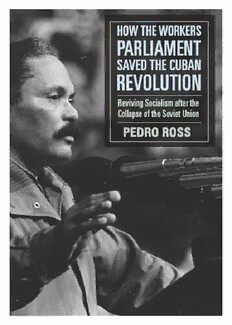
How the Workers’ Parliaments Saved the Cuban Revolution: Reviving Socialism after the Collapse of the Soviet Union PDF
Preview How the Workers’ Parliaments Saved the Cuban Revolution: Reviving Socialism after the Collapse of the Soviet Union
1 About the Author Beginning as a young construction worker Cuba, Pedro Ross became a teacher during Cuba’s great literacy campaigns of the 1960s, and served three terms as General Secretary of Cuba’s labor federation, the CTC (e Workers’ Central Union of Cuba)—and in that capacity developed a nationwide series of “Labor Parliaments” dedicated to some form of resolution to the economic collapse. Upon retirement, he was appointed Ambassador to Angola, a post he held for several years. Now in his eighties, he is still active in Cuba’s ongoing revolution. 2 3 HOW THE WORKERS’ PARLIAMENT SAVED THE CUBAN REVOLUTION Reinvigorating Resistance and Struggle after the Collapse of the Soviet Union PEDRO ROSS LEAL MONTHLY REVIEW PRESS New York 4 Copyright © 2022 by Monthly Review Press All Rights Reserved Library of Congress Cataloging-in-Publication Data available from the publisher. ISBN paper: 978-1-58367-978-4 ISBN cloth: 978-1-58367-979-1 Typeset in Bulmer MT Std MONTHLY REVIEW PRESS, NEW YORK monthlyreview.org 5 4 3 2 1 5 6 Contents Foreword by Chris Remington PART ONE A Brief Introduction Why Workers’ Parliaments? Fidel Saw It Coming A Congress in Military Uniforms What Is a Special Period in Peacetime? e Fourth Party Congress and the Start of the Special Period Measures to Address the Crisis Enemy Encouragement of Social Indiscipline and Vandalism Fidel Meets the People e People Respond “It Is Easier to Find a Dinosaur Crossing the Street an a Pumpkin in the Market” It Was Not the First Time “Yes, We Can” Why Do Unions Exist? Analysis, Measures, Actions e Second Ordinary Session of the National Assembly of People’s Power What the Workers Say in the Parliaments Fidel Reflects, Argues, Gives His Opinion, Promotes Discussion People Work Because ey Must “We Haven’t Always Done ings Right by Consulting” e Sources of the Black Market Our Proposal Workers’ Assemblies into Workers’ Parliaments e Call e Preparation e Workers Are the Owners A Light at the End of the Tunnel Unequivocal Support Sociopolitical and Opinion Studies: e First Survey A Vast School of Economics 7 e Issue of Prices Reducing Employment Rolls … But How? Our Meeting with the Cigar Workers’ Parliament Keeping Fidel Informed With the Milkmen in Pinar del Río Workers’ Parliaments in Camagüey e Workers’ Parliament at the Lenin Central Workshop With Fidel: Salary Guarantee and Other Topics e Building Contractor Contingents Exchanging Ideas with Fidel Another Survey: Workers Endorse the Parliaments Assessment Time: What Happened in the Parliaments? A Faint Ray of Light e Final Summary of the Workers’ Parliaments e Ministry of Finances and Prices Reports e Debate e International Solidarity of Trade Unionists Conclusions PART TWO e Nightmare of a Devastating Hurricane e Origins of Cuban Nationality A Fecund Truce Martí’s Legacy e Imperialist Intervention of the United States e Platt Amendment e Second Occupation of Cuba by the United States First Governments of the Neocolonial Republic e Machado Dictatorship e September 4 Coup d’état and the 100 Days Government Historical Significance of the Revolution of 1933 e 1940 Constitution Fulgencio Batista: Demagogy and Repression e Authentic Governments Eduardo Chibás: Decency versus Money e Coup of March 10, 1952 Popular Repudiation Grows 8 e Assaults of July 26, 1953 “Condemn Me, It Doesn’t Matter, History Will Absolve Me” e Release of the “Moncadists” e Granma e November 30 Uprising in Santiago de Cuba e National Liberation War e Triumph of the Revolution Cuba Transforms Itself Playa Girón (Bay of Pigs) New Paths e War Against the Bandits e United States Tries to Isolate Cuba e Mongoose Plan e October Crisis Cuba Built; the United States Attacked Transformations of Cuban Economy and Society Rectifying Errors e Revolution’s Social Initiatives e Cuban Revolution’s Foreign Policy Epilogue Appendix A Bibliography Notes 9
